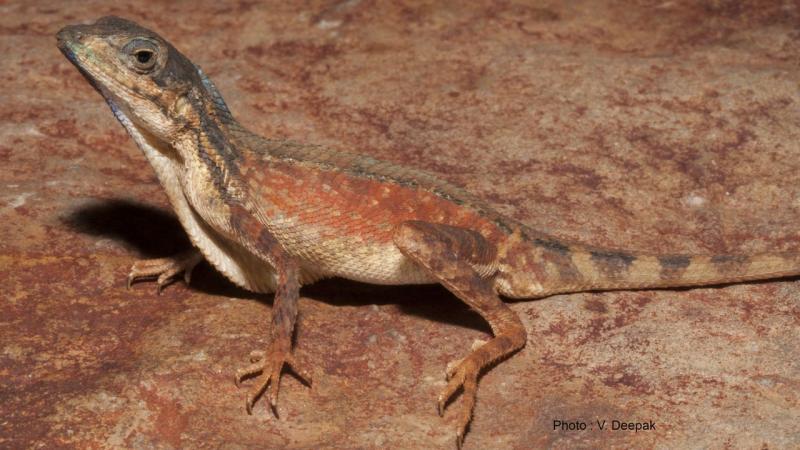
When we speak of biodiversity in peninsular India, all eyes and ears move towards the lush green Western Ghats—the well-known biodiversity hotspot. In comparison, the dry forests, scrublands and rocky outcrops that are characteristic of the Deccan plateau are viewed as barren and species-poor. In an exciting discovery, scientists from Indian Institute of Science, Bengaluru, and the Natural History Museum, London, have discovered two endemic species of Fan-throated lizards in these ‘barren’ landscapes.
Fan-throated lizards, as the name suggests, have a fold of loose skin hanging from the throat in males. Also, called dewlap, it is used in communication during the breeding season. In this study, published in the journal Zootaxa, the researchers have described two new species of Fan-throated lizards belonging to the genus Sitana; one from Karnataka and other from Andhra Pradesh. The study which was undertaken in Dr. Praveen Karanth's lab at the Center for Ecological Sciences, Indian Institute of Science, was funded by fellowships from the Department of Biotechnology and Rufford Small Grants.
Individuals of the genus Sitana are small, ground-dwelling lizards that form an essential part of the food chain in dry, arid landscapes. “Several birds, mammals and snakes prey on these species, and they feed on small insects”, says V. Deepak from IISc, who is the lead author of the study, talking about their role in the ecosystem as prey and predator.
Of the two new species, Sitana gokakensis was found and reported from, and named after Gokak taluk, in Belagavi district of Karnataka. The other, Sitana thondalu, was found in two adjacent areas near the Nagarjuna Sagar reservoir, at the foothills of the Nallamala range in Guntur district, Andhra Pradesh.

The two species are cryptic, meaning that they aren’t easily distinguishable just by their looks. Hence the researchers analysed their genes to tell them apart. They collected tissue samples to extract DNA from a lizard in each of the 12 sites they chose for the study.
“The lizards were hand-captured, and their tail samples were obtained before releasing them. We initially had only eight males between the two species, but once we realised they were cryptic species, we had to collect at least ten males per species to be able to identify them properly”, recalls Deepak. “Since we sampled during the breeding season, we tried to avoid capturing gravid (carrying eggs) females. Males were identified by the full colouration of the dewlap”, he further adds.
The researchers found that the two new species are distributed 500 km apart from each other and are endemic to their localities. S. gokakensis is found in the open rocky dry habitat of the Gokak plateau, characterised by thorny and dwarf succulent plants. S.thondalu, on the other hand, was found in the dry, rocky outcrops with sparse vegetation and stunted trees in Macherla and Nagarjuna Sagar in Guntur district.
The researchers also used specimen data for comparison from their previous study of 200 museum specimens of four different species maintained in various zoological institutions in Odisha, Kolkata and Pune. They used differences in their genetic codes and geographical separation to tell apart the two species as well as determine their endemicity.
“We had a good amount of molecular data that I collected from across India from 107 locations for an earlier genetic study. Hence, we were able to confidently ascertain that these two were endemic to the described localities. In this study, we also sampled extensively in the areas around and intervening the two species to find out if they were geographically isolated”, reasons Dr. Deepak. A phylogenetic tree analysis showed that the two species were genetically different. The deeper and farther away the branches of the species are on the tree, the more genetically distinct they are. In this case, they showed deep divergence, to be considered as separate species.
As expected in cryptic species, morphological measurements showed that the two species had considerable overlap. Even so, they are used as a standard protocol to help list out diagnostic characters that are useful when describing a new species.
Explaining the usefulness of these measurements, Deepak adds, “Sitana are broadly separated into groups by its dewlap type and colours. Within groups, to identify cryptic species, different morphological measurements may be used. In the case of lizards, they could be a number of certain scales, their size, body ratios or a combination of these”.
This study did not look at the reason behind the endemicity. However, the authors speculate that rocky, barren rivers, with deep peaks and troughs, can be a barrier for species dispersal, as the Sitana cannot climb such terrains. In this case, the rocky Ghataprabha river surrounding the Gokak plateau and the Krishna river along with the Nallamala hills around Nagarjuna Sagar have possibly restricted the distribution range of these species. However, the study urges for a more finer level of detailed sampling required to map out the distribution of the two new species.
It also highlights the importance of these dry-zones for the possible discovery of many other endemic reptilian species. The South Asian lizard genus, Sitana currently has 12 species, with most having been discovered only since the late 90’s. “The region is under represented in terms of data because of poor sampling and lack of systematic studies. They might well be biodiversity rich, harbouring many endemics that can serve as keystone species for conservation of these barren landscapes”, say the authors. More cryptic species are being discovered from the Indian subcontinent, across various taxa, even as we speak. It is therefore important that future studies focus on large sample sizes combined with latest molecular methods, to clearly delineate between species.






